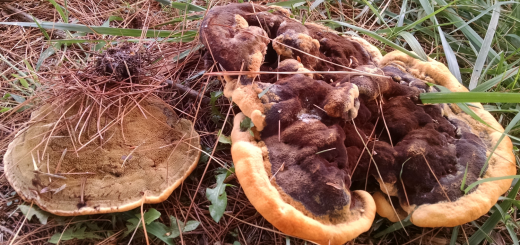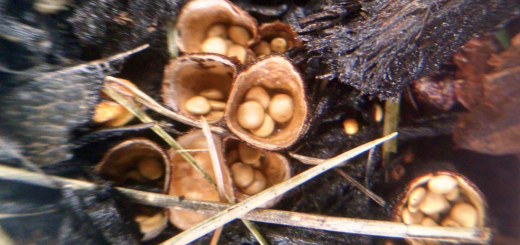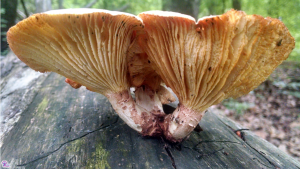#153: Geastrum fornicatum
In celebration of last night’s meteor shower, I have chosen to discuss a little star that can be found during the day in some parts of North America: the earthstar Geastrum fornicatum. Earthstars are all very similar: they have a puffball-like center surrounded by several pointed “arms,” grow on the ground, and are brownish in color. fornicatum can be distinguished from most other North American earthstars because its arms lift the circular center well above the ground. For this reason, it is called the “Arched Earthstar” (“fornicatum” actually translates to “arched”). G. fornicatum is most commonly found in Southwestern North America, but can be found elsewhere around the world.
When young, G. fornicatum is a spherical mushroom that could easily be mistaken for a puffball, a button of an agaric, or a clod of dirt. At this time, the earthstar is only 1.5-2.5cm wide (0.6-1in). One of the distinguishing features of this earthstar is that it is attached to its substrate all over its outer surface. As a result, all of the dirt and debris surrounding the mushroom is securely fastened to it. Other earthstars are attached at a single point and can easily be separated from the surrounding debris.
When the earthstar is mature, the outer layer splits radially from the center and peels back. This results in the creation of 4-6 “arms” or “rays” (usually 4) that surround a puffball-like center. The outer layer that is covered in debris remains roughly cup-shaped while the arms recurve and arch upward. Since the arms remain attached to the cup at the tips, the mushroom is able to raise itself well above the surrounding leaf litter. The resulting effect is reminiscent of an octopus standing on a bowl. When fully extended, G. saccatum is up to 6cm (2in) wide and 8cm (3in) tall. The rays are dark brown from the top, but the upper layer often cracks to reveal a lighter brown underneath.
The central, puffball-like “spore case” of G. fornicatum grows 1.5-2.5cm (0.6-1in) wide and is colored dark brown, sometimes with shades of blue or purple. It is spherical but often somewhat flattened and is held slightly above the surface of the arms by a short, neck-like stalk. Many earthstars lack this stalk, which helps separate out this species. At the top of the spore case, G. fornicatum has a roughly conical pore. This pore is rather unusual among earthstars because it is often irregular in shape and is fringed or fibrous around the rim. The region immediately surrounding the pore is not distinctive, which also helps separate out this species.
The interior of the spore case is filled with spore-producing tissue. Initially, this tissue is firm and white. As the earthstar matures and produces spores, the spore case’s interior becomes powdery and dark brown. The spore print – which can be taken by flipping the mushroom upside-down over a piece of paper and squeezing the spore case – is likewise dark brown. If you look at them under a microscope, you will be able to see that the spores are decorated with tiny warts. Earthstars use the same method of spore dispersal as puffballs do. When a raindrop falls on the spore case, it forces some of the powdery spores inside to be puffed out. The spores are then carried by air currents to new habitats.
G. fornicatum is a saprobic mushroom, meaning it decomposes dead organic material. It prefers decomposing forest litter and usually fruits on the ground rather than directly from wood. You can find this mushroom under conifers (especially Monterey Cypress in California and yew in Europe) from late summer through winter, though the mushrooms are hardy and can often be found months later. G. fornicatum is common in Southwestern North America but is occasionally found in other parts of North America as well as Europe and Australia (and likely other continents as well). There are a number of species of earthstar that look very similar, so you will need a good key to accurately differentiate between them.
Most people count earthstars as inedible, though some speculate that they may be edible while the spore-producing tissue is still white and firm. For most people, however, the tough outer skin makes even the buttons undesirable. Additionally, G. fornicatum is relatively small and you would need many mushrooms to make a satisfying dish. The First Nature webpage linked below suggests that earthstars can be made into attractive table decorations. Other than this, G. fornicatum is not used for anything.
See Further:
http://www.rogersmushrooms.com/gallery/DisplayBlock~bid~5948~gid~~source~gallerydefault.asp
http://www.mykoweb.com/CAF/species/Geastrum_fornicatum.html
http://www.first-nature.com/fungi/geastrum-fornicatum.php
http://australianfungi.blogspot.com/2010/08/45-geastrum-fornicatum.html









![#011: Characteristics of Kingdom Fungi [Archived]](https://www.fungusfactfriday.com/wp-content/themes/hueman/assets/front/img/thumb-small-empty.png)


1 Response
[…] ground. It also forms a pedicel that slightly raises the gleba above the center of the star. In Geastrum fornicatum the mesoperidium (middle layer) splits from the exoperidium (outer layer), except at the tips of […]